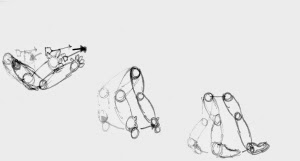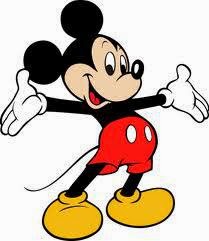Persistence Of Vision
Persistence of vision is the phenomenon where the eye sees an 'afterimage' for about one twenty-fifth of a second on the retina after the image has been seen. This helps create the illusion of motion, which is important in animation because it helps the sequence seem to flow. It helps the sequence flow because the eye doesn't notice the individual movements in each frame because the persistence of vision fills in the gaps.
The Twelve Principles Of Animation
1. Squash And Stretch
Squash and stretch gives the illusion of weight and volume whilst a character is moving. It also makes a characters facial expressions more dramatic and animated. Animators often use this technique on anything from a bouncing ball to the body of a character walking.
2. Anticipation
Anticipation is where a backwards motion occurs before the forwards action takes place. It can be used to express a characters personality. An example of anticipation could be when a character is about to run, jump, kick a ball or change expression. When about to kick a ball the character will bend their leg backwards before kicking the ball forward.
3. Staging
Staging is about the position of the camera and the variety of different shots you can take. Staging helps the audience get a feel for whats going on, and helps set the scene. An action or pose would be used to connect the audience to the characters and is used to clearly communicate the mood, attitude or reaction of the character. Staging is used to direct the audiences focus on to the story.
4. Straight Ahead And Pose To Pose Animation
This technique is where the animator will draw each frame from the first to the last of the scene, where they are able to plan out each individual pose. This technique is used to produce fast, wild action scenes. It is not used that often because there is more of a chance you can lose size, volume and proportion.
5. Follow Through And Overlapping Action
Follow through is where the different parts of a character stop at different times. For example a characters coat, hair, ears or any other clothing will stop moving after the main body does. Overlapping is when a characters hair or clothes continue to move in one direction for a few frames after the main body of a character changes direction. An example of this when snow white starts to dance and her dress takes a few frames to move in the same direction of her body.
6. Slow-out And Slow-in
This technique is where an action will have more frames drawn at the beginning and end of a pose and fewer in the middle. This is used to make a characters action more realistic and it is used to make a movement seem faster. It is also used to soften the action which also makes it more life like.
7. Arcs
Arcs are used to give animation a more nature action and better flow. all natural movements like arms swinging, heads turning and eyes moving are all executed on arcs.
8. Secondary Action
Secondary action is when another action is added to the initial action to enrich and emphasise this first action. For example if a character is walking, a secondary action may be the character talking or swinging their arms. All these actions are used to support each other.
9. Timing
Using a range of timings is important is to make the action more realistic and make the show more interesting. The more drawings between poses slow and smooth the action and the fewer drawing make the action speed up.
10. Exaggeration
Exaggeration is used to make the animation seem more appealing to the audience. In animation, the characters must move more broadly to look natural. Exaggeration is used in the walking, head turns and eye movements.
11. Solid Drawings
Solid drawing involves taking into consideration volume and weight. Solid drawings are created using pencil sketches and drawings and colour and movement is added on top afterwards on a computer. The purpose of the colour and movement is to give the illusion of three diminutional movement in space.
12. Appeal
All characters in animation need appeal whether they are heroic, villainous or cute. Appeal includes clear drawings and personality development, which is used to capture and involve the audiences interest. Characters need to appeal to they mind as well as the eye.












No comments:
Post a Comment